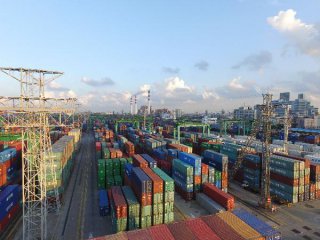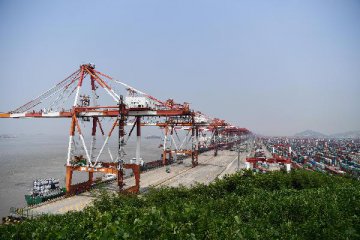
Trading experts warn of cyclical risks of some merchandise.
In the latest World Trade Outlook Indicator (WTOI) report released on the November 13, the World Trade Organization (WTO) predicts that global merchandise trade growth will likely moderate in the fourth quarter. Trading experts warned that the global trade situation still faces risks due to the cyclical factors in some merchandise and the remaining anti-multilateral momentum.
The report shows that the WTOI stood at 102.2 in the fourth quarter of this year, slightly lower than the 102.6 in the third quarter, but still higher than the expansion –contraction line. This means that the trade volume continued to grow, although the pace of growth was slower.
Specifically, the indicator of export orders in the WTOI dropped slightly, but still remained above the trend level. The indicator of air cargo transport and container throughput also maintained above the trend level, but lacks upward momentum and is likely to slow down in the future. The WTOI on electronic components and agricultural raw materials is also rising.
The report also noted that although the production and sales growth in the automobile industry remained weak, there emerges signals of bottoming out, indicating that the consumer confidence is growing.
The Wall Street Journal said in an article that “the world trade downturn which has continued for years has finally reversed. Emerging markets that are highly dependent on exports are expected to be boosted.”
Looking at Asia's exports, there is a momentum of rapid growth. The exports of South Korea, Singapore and Vietnam increased by 18 percent, 12 percent and 20 percent from the same period of last year, respectively. China's exports increased 6 percent, a reverse from the past two years.
Driven by global economic growth, the gross domestic product (GDP) of South Korea in the third quarter achieved its fastest growth in seven years. The country's economy is expected to see a 3 percent growth this year. Singapore's third quarter economic growth hit the highest level in over three years. The Singapore government said that it expects economic growth will be close to 3 percent.
Michael O’Sullivan, chief investment officer of the International Wealth Management Department of Credit Suisse and co-author of Getting Over Globalization, said that the world economy is in a phase of sound development. It is a timing that trade growth should accelerate.
Natixis Bank senior economist Trinh Nguyen told the media that he believes the trade will not shrink in the long term, but the growth rate may slow down.
For Asian countries, new exports demands continue to emerge. And the improvement in the external environment has made trade better.
As an important trading partner of the Asian market, Europe has finally begun to step out from the post-crisis era, boosting the demand for goods ranging from sneakers to electronics. In Japan, the long-suppressed consumption has finally steadily risen this year. The United States also sees accelerated economic growth after its eighth year of expansion.
Although the WTO estimates that global trade will grow by 3.6 percent in 2017, the reading is well below the annual average of about 6 percent of the two decades before the financial crisis.
The recent rebound momentum in trade may see cyclical impact in the future. For example, this year's export growth in Asia is largely driven by a wave of semiconductor demand. These semiconductors are used in new smartphones like the iPhone X. Demands for chips are expected to subside next year. Economists warn that although the recent growth looks strong partially compared to 2016, the comparative base will not be as favorable by 2018.
According to the World Semiconductor Trade Statistics Association (WSTS), a nonprofit organization that tracks the semiconductor industry, the semiconductor market has grown 17 percent this year, but is expected to grow only 4 percent next year as supplies continue to catch up demands. Growth will further slowdown in 2019. The semiconductor production in East Asia accounts for nearly 70 percent of the world's total semiconductor output.
The Wall Street Journal also pointed out in the article that as aging populations in developed countries spend more on health care and medical care services, the demographic trends may also make commodity trade harder to grow at a faster pace. Some Asian exporters also face different challenges in terms of demographic structure, such as the shrinking low-cost labor force.
The WTO’s maintenance of the global multilateral trading system has also been hit by the bilateral system claimed by some countries, and also brought risks to global trade.
WTO Deputy Secretary-General Wolf said that after the World War II, the 3estern countries headed by the United States and Britain were determined to take the road of "free and fair trade". Since the establishment of the WTO for more than 20 years, the existing rules have indeed to be improved in order to solve new trade issues. But the multilateral system must be cherished and maintained. It will pay a huge price if one contempt the system.
Wolf said that in the future the WTO may move forward as a collective leader. And the best solution is still that the U.S. should return to the multilateral system.
Translated by Coral Zhong





















Latest comments